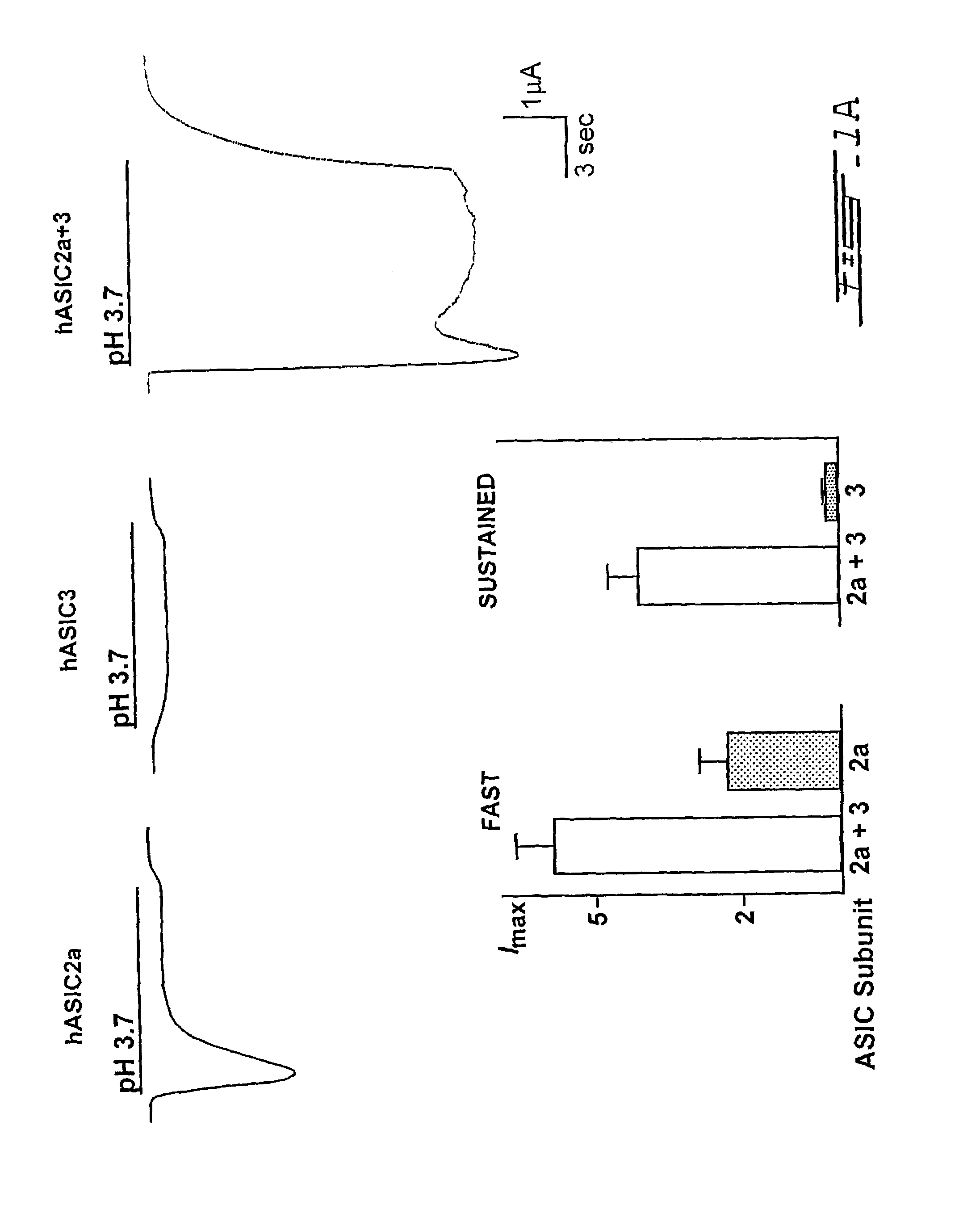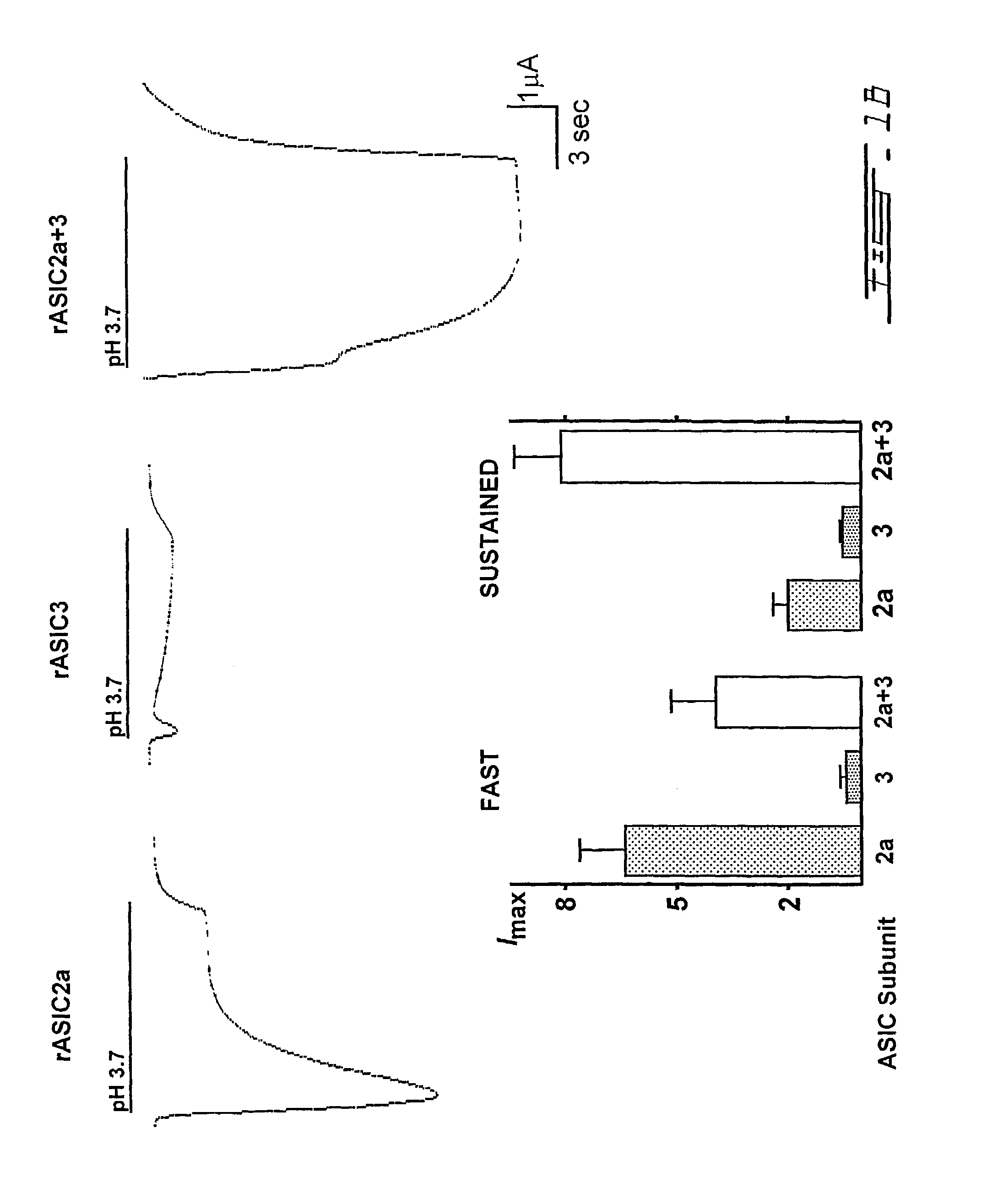Heteromultimeric ion channel receptor and uses thereof
a heteromultimeric ion channel and receptor technology, applied in the field of new acid sensing ion channels, can solve the problems of heteromultimeric asic channel composition and functional characteristics that are unpredictable, and no biochemical evidence of interaction has been reported to date for any asic subuni
- Summary
- Abstract
- Description
- Claims
- Application Information
AI Technical Summary
Benefits of technology
Problems solved by technology
Method used
Image
Examples
example 1
Vector Constructs for the Functional Expression of ASIC-2S.2 Channels
[0177]Method 1: Expression of ASIC-2S.2 is accomplished by introducing into appropriate host cells, by various injection or transfection techniques known to one skilled in the art, two separate vectors comprising the nucleic acids encoding, respectively, the ASIC2A and ASIC3 polypeptides of SEQ ID NO:2 or NO:6 and SEQ ID NO: 4 or NO:8. A preferred eukaryotic expression vector is pcDNA3 (InVitrogen), or any derivatives thereof. Based on nucleic acid sequences of SEQ ID NO:1, SEQ ID NO:3, SEQ ID NO:5 and SEQ ID NO:7, specific oligonucleotide primers are designed immediately upstream and downstream, respectively, of the initiation and the stop codons. All primers are extended to add artificial restriction sites (e.g. forward primers with EcoRI and reverse primers with XbaI), allowing RT-PCR amplified full length nucleic acids to be directionally subcloned into pcDNA3. Ligated products are used to transform E. Coli str...
example 2
Expression of Functional ASIC-2S.2 Channels in Xenopus laevis Oocytes
[0180]According to method 1 described above, nuclei of Xenopus oocytes are injected with ASIC2A and ASIC3 cDNAs separately subcloned into pcDNA3 expression vector (1-5 ng). Control oocytes are injected with H2O. Oocytes are maintained at 18° C. in modified Barth's solution. Proton-activated currents are measured by two-electrode voltage clamp 1-3 days after injection. During voltage clamp (−60 mV / −100 mV)), oocytes are bathed in 116 mM NaCl, 2 mM KCl, 1.8 mM CaCl2, 10 mM acetic acid and 5 mM Hepes (pH 7.4 with NaOH). To determine proton-gating, bath solution is quickly switched to a solution of pH1B (rat) compare proton-activated currents carried by homomultimeric ASIC2A and ASIC3 receptors to the heteromultimeric ASIC-2S.2 receptors (ASIC2a+3). The much greater amplitude and the consistent biphasic profile of the current recorded in co-injected oocytes clearly reveals the existence of a novel proton-gated channel ...
example 3
Tissue Distribution of ASIC2A and ASIC3 Transcripts Using RT-PCR
[0183]To document the co-expression of ASIC2A and ASIC3 mRNA in various tissues, specific oligonucleotide primers are designed and used in a duplex RT-PCR protocol. Fragments of 470 and 340 bp are amplified, respectively, with ASIC2A-specific (SEQ ID NO: 11 and SEQ ID NO: 12) and ASIC3-specific (SEQ ID NO:13 and SEQ ID NO:14) primers, enabling the co-amplification of both fragments from a single sample. The reaction is carried out with the EXPAND long-template polymerase mix, containing both Taq and Pwo polymerases (Roche), according to the manufacturer's instructions. Briefly, the reaction mix includes: dNTPs 0.5 mM, forward and reverse primers 1 μM each, RT-cDNA template 5 μL, 10×PCR buffer 5 μL and polymerase enzyme mix 0.75 μL, all in a final volume of 50 μL. Samples are kept at 4° C. and the enzyme mix is added last. Tubes are then immediately transferred to the thermocycler preheated to 94° C., after which cycling...
PUM
| Property | Measurement | Unit |
|---|---|---|
| pH | aaaaa | aaaaa |
| pH | aaaaa | aaaaa |
| pH | aaaaa | aaaaa |
Abstract
Description
Claims
Application Information
 Login to View More
Login to View More - R&D
- Intellectual Property
- Life Sciences
- Materials
- Tech Scout
- Unparalleled Data Quality
- Higher Quality Content
- 60% Fewer Hallucinations
Browse by: Latest US Patents, China's latest patents, Technical Efficacy Thesaurus, Application Domain, Technology Topic, Popular Technical Reports.
© 2025 PatSnap. All rights reserved.Legal|Privacy policy|Modern Slavery Act Transparency Statement|Sitemap|About US| Contact US: help@patsnap.com



